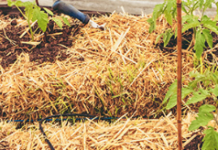K-State horticulture expert shares tips for picking crops at the right time
MANHATTAN, Kan. – Sometimes, harvesting fruit and vegetables in Kansas can be a waiting game.
Gardeners often need to patient and look for key indicators to know when some of the more popular fruits and vegetables are ready to be harvested, according to Kansas State University horticulture expert Ward Upham.
Knowing when to harvest crops is a key to enjoying them later, said Upham, who shared some thoughts on what to look for:
Apples
Upham said apples mature over a long period of time depending on the variety. “Some varieties, such as Lodi, can mature in July, while others mature as late as October or even November,” he said.
Some tips for knowing when to pick apples include:
• Days from bloom. For some common varieties, the number of days after the tree blooms to when the apples should be ready include: Jonathan, 135; Delicious, 145; Golden Delicious, 145; and Winesap, 155. Weather conditions may influence those guidelines.
• Flesh color. As apples mature and starches change to sugars, the flesh changes from very light green to white. Cut a thin slice and hold it to light to determine if the flesh is white.
• Seed color. The seeds of most apples change from light green to brown as the fruit ripens. This indicator should be combined with other changes.
• Color change. As apples mature, the skin color in the areas of the stem and the bottom of the apple turns from immature green to a light-yellow color. Some apples turn red over the majority of the fruit before they are ripe, so this is not a reliable indication of maturity.
• Flavor. Sample a few slices and decide if they have a sweet flavor. If they are not ready to harvest, they will taste starchy or immature. If apples have fallen before they are ripe, store them for a period to see if they become more sweet.
Pears
Most pear cultivars should not be allowed to ripen on the tree, but rather picked while still firm and ripened after harvest. Upham said pears ripen from the inside out: “Waiting until the outside is completely ripe will often result in the interior of the fruit being mushy and brown,” he said.
Home gardeners can look for these cues to determine when pears are ready to be picked:
• Color. The fruit’s background color – known as its ‘ground’ color — changes from dark green to light or yellowish green when ripe.
• Attachment to tree. The fruit should part easily from the branch when it is lifted and twisted.
• Corking over the lenticels, the fruit’s breathing pores. Initially, they are white to greenish white, but turn brown as the fruit nears maturity. Lenticels look like brown specks on the fruit when it is ripe.
• Smell and taste. When pears are ripe, you should be able to smell the characteristic aroma.
Zucchini
Upham said summer squash is harvested while immature, but winter squash (including acorn, hubbard and butternut) is harvested in the mature stage when the rind is tough and seeds have developed.
“We normally think September is the time that winter squash are harvested, but harvesting too early leads to fruit that shrivels and rots,” Upham said.
He notes that color and rind toughness are the two most important characteristics indicating when winter squash is ready.
“Winter squash changes color as it becomes mature,” said Upham, noting that butternut changes from light beige to tan; acorn starts deep green but forms a ground spot that is orange when ripe; and hubbard is gray or orange when mature.
Winter squash should also have a hard, tough rind, Upham said. “This is easily checked by trying to puncture the rind with your thumbnail or fingernail. If it easily penetrates the skin, the squash is not yet mature and will lose water through the skin, causing the fruit to dry and shrivel.”
Upham and his colleagues in K-State’s Department of Horticulture and Natural Resources produce a weekly Horticulture Newsletter with tips for maintaining gardens and home landscapes. The newsletter is available to view online or can be delivered by email each week.
Interested persons can also send their garden- and yard-related questions to Upham at [email protected], or contact your local K-State Research and Extension office.
-30-
FOR PRINT PUBLICATIONS: Links used in this story
K-State Horticulture Newsletter, https://hnr.k-state.edu/extension/info-center/newsletters/index.html
K-State Research and Extension local offices, www.ksre.k-state.edu/about/stateandareamaps.html
K State Research and Extension is a short name for the Kansas State University Agricultural Experiment Station and Cooperative Extension Service, a program designed to generate and distribute useful knowledge for the well being of Kansans. Supported by county, state, federal and private funds, the program has county extension offices, experiment fields, area extension offices and regional research centers statewide. Its headquarters is on the K State campus in Manhattan. For more information, visit www.ksre.ksu.edu
Story by:
Pat Melgares
785-532-1160
[email protected]
For more information:
Ward Upham
785-532-6173
[email protected]




